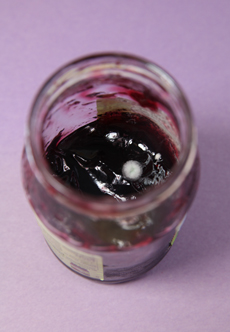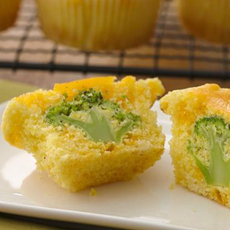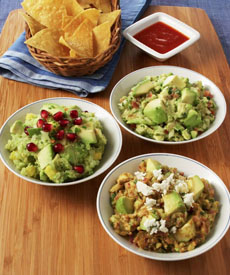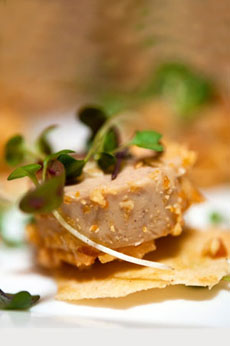|
If you’re not familiar with the cape gooseberry, the fruit’s short season begins soon. Keep an eye out, and pick up a box.
There are different varieties of gooseberry, but our focus here is the cape gooseberry (Physalis peruviana), also called the Peruvian groundcherry and the goldenberry, the uchuva (in Columbia) and fruta del amor (love fruit—in Peru).
It’s a close relative of the tamarillo and the tomatillo, as well as the tomato—all members of Solanacaea, the Nightshade* family. The genus originated in the Andes Mountains, in the area that is now Ecuador, Colombia, and Peru.
The “cape” is a paper-thin green covering that dries to a tan or greenish ecru papery husk. The husk is left on for attractive garnishing and removed for cooking.
There are also capeless varieties, which are similar in taste but lack the delicate beauty of the cape.
Because of the scarcity and the cost, cape gooseberries are used sparingly, often as colorful garnishes on plates or cocktail glasses.
But these flavorful little fruits, looking like miniature cherry tomatoes, are eaten as berries or cooked into chutneys, compotes, desserts, jams and jellies, meat glazes, pies, purées, sauces, or garnishes for plates and beverages.
For a fancy dessert garnish, dip them in chocolate.
The berries need to be eaten when they are very ripe; otherwise, they can be tart.
But as part of your adventures in food, experiment. If they aren’t sweet enough, you can bathe them in sugar water, sprinkle them with sugar or cook them with added sugar.
> Take a look at the two recipes below: Poached Gooseberries and a versatile Gooseberry Butter Sauce.
HISTORY OF THE CAPE GOOSEBERRY
Thousands of years ago, Inca farmers high in the Andes cultivated the wild bounty that grew on their lands: sixty varieties of beans, cape gooseberries, cherimoya, dragon fruit, peanuts, potatoes, prickly pear, squash, tamarillo, tomatoes, and quinoa, among other crops.
The bright orange berry, also called the Aztec berry, golden berry, ground cherry, husk tomato, Inca berry, Peruvian cherry, and poha, grows at 7,500 to 10,000 feet. Traders brought them to Florida and Louisiana in the 1700s. Cajuns brought them to Quebec, where they are still cultivated.
They grow wild throughout a great part of the country They are cultivated in the U.S. and also grow wild here, having escaped their cultivated fields centuries ago. They are grown in Europe and as far away as Australia, which cans them for distribution to the rest of the world.
RECIPE #1: POACHED GOOSEBERRIES
Thanks to Andrew Faulkner of Melissas.com for this recipe.
Ingredients
2 cups sugar
1 cup water
4 small lemon
1-1/2 pints gooseberries, husks removed
Preparation
1. COMBINE the sugar and water, bring to a boil and boil for 8 to 10 minutes.
2. ADD the lemon and gooseberries and cook for 5 minutes, until the fruit is just cooked through (about 12 minutes in all).
3. COOL in the syrup. Serve as a topping for ice cream, or serve warm over sponge cake or angel cake with whipped cream.
RECIPE #2: GOOSEBERRY BUTTER SAUCE
This sauce, by Tom Fraker for Melissa’s Produce, can be served over squash, a white fish fillet, or as a dessert sauce.
Ingredients
3 pints gooseberries, husks removed
8 ounces unsalted butter
1 cup brown sugar
6 ounces dry sherry
|
|

[1] Cape gooseberries (photo © Rose Jones | Flickr).

[2] You can see why cape gooseberries in their husks make a lovely garnish (photo © Lucas George Wendt | Unsplash).
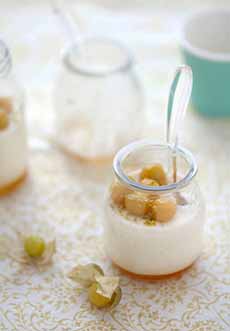
[3] Panna cotta with poached gooseberries. Here’s the recipe (photo © Cannelle Vanille).

[4] Antidote chocolate is made in Ecuador, home of gooseberries, which they add to chocolate (photo © Antidote Chocolate). |
